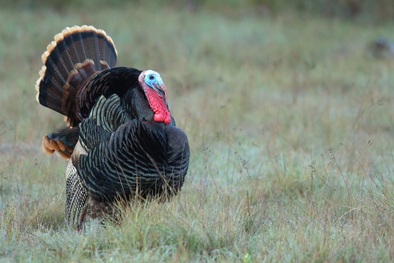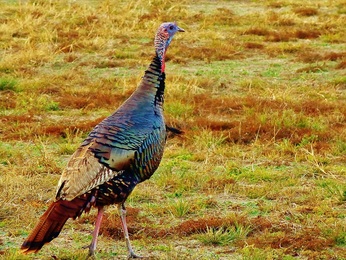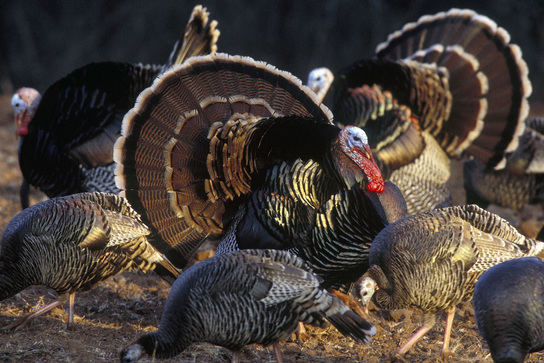The Intro
 Wild Turkey Display
Wild Turkey Display Turkeys are one of the most well know birds in North America for their contribution to several special days in the fall and winter season. Thanksgiving just wouldn’t be the same without the contribution this bird has added to most of the people that live on this continent. The history of this majestic bird in the wild would most likely surprise you as being a huge success story. The surprise is not the success, but the fact that we very nearly lost the Wild Turkey in its natural habitat. Today, turkeys are found in almost every state, several provinces and some location in Mexico as well. Let’s find out a little bit more about this fabulous bird, let’s talk turkey
The Name
The Wild Turkey (Meleagris gallopavo) has a twisted path back to the reason a North American bird is named after an Eastern European country. This game bird was most likely named for a similar bird that was common at the table in England, pre 1500, which was called a Turkey. This was really an African bird whos common name is the Guinea fowl. The Guinea fowl got its English name because of the Turkish traders that brought them through the eastern country of Turkey and then west. It is believe that these same Englishmen that landed on the continent of North America saw our large bird in the forests of Massachusetts and figured, why confuse things, they both look similar on the plate, and so Turkey it was. The scientific name or binomial nomenclature is due to the bird described as being similar to several other birds in the Old world. The genus comes from the greek story of Meleagris’ sisters being turned into Guinea Fowl. The second name, or species name, comes from the word Gallo, which translated is chicken and the word Pavo which is Latin for peacock. Hence the literal translation for Wild Turkey is Guinea Fowl, Chicken, Peacock. The funniest part is, a good deal of European countries call the American Turkey and Indian bird, like in France where they named the bird poulet d’ Indie, or dinde for short.
The Bird
The Wild Turkey is the largest member of the game bird family native to North America which includes grouse, quail and ptarmigan. This bird has a wingspan of four and a half feet and can be 4 feet tip to tail. The Wild Turkey is found throughout the United States, Southern Canada and parts of Mexico with 6 known sub species that differentiate the bird in different areas. The Eastern United States form is the most recognized. The Turkey is dark overall with a bronze or copper sheen to the feathers except for the featherless heads which are brightly colored in the males. The males have a blue and red head that is accentuated in the breeding season as the skin and wattles fill with blood giving them the prettiest of looks. Both sexes can also have a “beard” that hangs from their neck which consists of modified feathers. The display of the males is one of the most recognizable images of the turkey with children all over North America tracing their hands and letting their imaginations do the rest. This display is performed in the spring and is accompanied by the well-known gobble, which can be heard up to a mile away. The large tail display is one way of telling your birds apart. If the tail is tipped with a chestnut color then you are most likely looking at an Eastern Wild Turkey. If you are looking at white tipped tail and rump feathers, you are looking at the Rocky Mountain, or Mexican race.
The Conservation

The fact is, Wild Turkeys were nearly hunted out of existence in most parts of North America. We almost lost our biggest game bird to over hunting. In between 1930 and 1940 it is estimated that there were only 30,000 birds left in all of the United States and absolutely none in Canada. These birds were in the furthest reaches of the wilderness and in very isolated groups where they were rarely seen by people. Over 40 years, hard work from game officials and individuals around the continent have brought turkey populations back by reintroduction of birds to historical areas. They have even done well in areas that were not historical like Hawaii although not all introductions are a good thing. In early 1970’s the Wild Turkey rebounded to over a million birds and hunting was declared legal again in the 70’s and 80’s. Today the birds number over 7 million birds and is of least concern making it one of the most successful recovery stories of the last 100 years.
The Facts
- Turkeys were noted by Benjamin Franklin as being “a more respectable bird” to represent the United States of America’s national bird than the Bald Eagle. We all know how that ended.
- Turkeys are one of the only birds from North America to be significantly domesticated world-wide besides the Muscovy duck.
- The domesticated Turkey was originally from Mexico and brought to Europe. There are some that believe the domesticated form of the Turkey was brought back to North America on the Pilgrim’s boats.
- More than 200 million domesticated turkeys are consumed a year in the United States
- Wild Turkey’s fly very well and can reach up to 55 mph
The Finish
The Wild Turkey has been a staple in our holiday meals for hundreds of years and is mostly known for its relationship with Thanksgiving. There is so much more to this hearty bird that came back from the edge of extinction and is one of the greatest success stories of North America. Turkeys are part of our landscape and our lives. Seeing a flock of these birds in the wild is truly a testament to the work of some hard working people that wanted to see the large and magnificent bird flourish. Thanks for talking Turkey.

